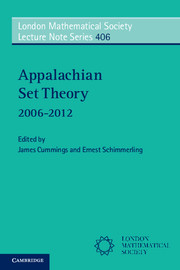Book contents
- Frontmatter
- Contents
- Contributors
- Introduction
- 1 An introduction to ℙmax forcing
- 2 Countable Borel equivalence relations
- 3 Set theory and operator algebras
- 4 A tutorial on Set Mapping Reflection
- 5 An introduction to hyperlinear and sofic groups
- 6 Aronszajn trees and the SCH
- 7 Iterated forcing and the Continuum Hypothesis
- 8 Short extender forcing
- 9 The complexity of classi?cation problems in ergodic theory
- 10 On the strengths and weaknesses of weak squares
- 11 Proper forcing remastered
- 12 Set theory and von Neumann algebras
- 13 The HOD Dichotomy
9 - The complexity of classi?cation problems in ergodic theory
Published online by Cambridge University Press: 05 December 2012
- Frontmatter
- Contents
- Contributors
- Introduction
- 1 An introduction to ℙmax forcing
- 2 Countable Borel equivalence relations
- 3 Set theory and operator algebras
- 4 A tutorial on Set Mapping Reflection
- 5 An introduction to hyperlinear and sofic groups
- 6 Aronszajn trees and the SCH
- 7 Iterated forcing and the Continuum Hypothesis
- 8 Short extender forcing
- 9 The complexity of classi?cation problems in ergodic theory
- 10 On the strengths and weaknesses of weak squares
- 11 Proper forcing remastered
- 12 Set theory and von Neumann algebras
- 13 The HOD Dichotomy
Summary
The twelfth Appalachian Set Theory workshop was held at Vanderbilt University in Nashville on October 30, 2010. The lecturer was Alexander S. Kechris. As a graduate student Robin D. Tucker-Drob assisted in writing this chapter, which is based on the workshop lectures.
Dedicated to the memory of Greg Hjorth (1963–2011)
The last two decades have seen the emergence of a theory of set theoretic complexity of classification problems in mathematics. In these lectures we will discuss recent developments concerning the application of this theory to classification problems in ergodic theory.
The first lecture will be devoted to a general introduction to this area. The next two lectures will give the basics of Hjorth's theory of turbulence, a mixture of topological dynamics and descriptive set theory, which is a basic tool for proving strong non-classification theorems in various areas of mathematics.
In the last three lectures, we will show how these ideas can be applied in proving a strong non-classification theorem for orbit equivalence. Given a countable group Γ, two free, measure-preserving, ergodic actions of Γ on standard probability spaces are called orbit equivalent if, roughly speaking, they have the same orbit spaces. More precisely this means that there is an isomorphism of the underlying measure spaces that takes the orbits of one action to the orbits of the other. A remarkable result of Dye and Ornstein-Weiss asserts that any two such actions of amenable groups are orbit equivalent.
- Type
- Chapter
- Information
- Appalachian Set Theory2006–2012, pp. 265 - 300Publisher: Cambridge University PressPrint publication year: 2012

